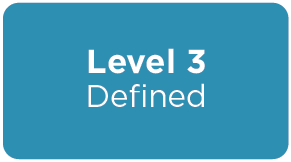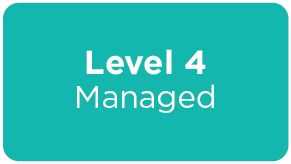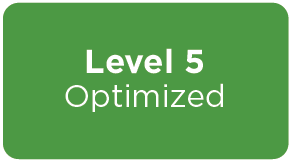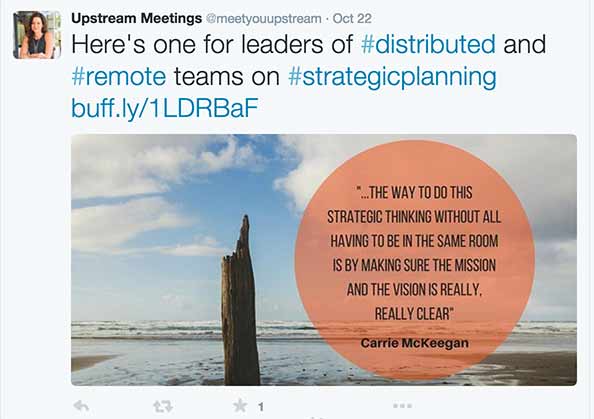The Meeting Performance Maturity Model (and How to Measure Yours)
Update September 2018
This blog post introduced the Meeting Performance Maturity Model (MPMM) for the first time. The latest published version of the MPMM can be found here.
Learning to run a meeting well is a worthy accomplishment. In successful meetings, teams unite and work takes flight.
When all goes well, that is. Run poorly, meetings are a blight on productivity.
Leading one good meeting matters, but as we all know, meetings are not solitary beasts. Only bad meetings live alone; failed sales calls and botched negotiations are not joined by a second meeting.
The rest of our meetings travel in packs, each connected to and reliant on the success of the meetings that surround them.
Some organizations understand this. They know that the way meetings work has an outsized impact on how the organization works.
Some organizations put this understanding to work, and actively shape the meetings that shape their culture. They know that how they meet largely defines who they are.
We can chart how well an organization manages meetings with a standard performance maturity model.
Introducing The Meeting Performance Maturity Model
The levels of meeting performance maturity described here build upon those defined in the Capability Performance Maturity Model, a standard which can be applied to many organizational functions.
Level 1: Ad Hoc – “Winging It”
- Almost no repeatable meeting process.
- Meetings are poorly controlled and reactive.
- Success is entirely dependent on the individual meeting leader’s ability.
Level 2: Repeatable – Dependent
- Meeting success is managed by one or more skilled individuals who “know what to do”.
- Individuals improve through independent learning, but there is no organization-owned focus on meetings.
Level 3: Defined – Standardized
- Standard meeting processes are defined for key meetings within the organization.
- The organization provides some training and guidance on how to run meetings.
- Individuals tailor their processes from the organization’s standards.
Level 4: Managed – Core Competency
- The organization monitors and measures meeting performance numbers.
- Standard meeting processes get updated, and new ones are added as needed.
- Facilitation is a recognized and supported skill.
- Individuals become accountable for achieving meeting performance expectations.
Level 5: Optimized – World Class
- The organization has “a way” to meet that embeds their values and strategic priorities.
- The organization maintains critical focus on meeting effectiveness.
- Feedback loops are in place to update and adapt meeting processes.
- The organization ensures access to trained facilitation resources.
- Meeting performance is job performance. Individuals expect effective meetings because they meet to get work done.
Meeting Performance Maturity in Practice
Moving beyond the basic definitions above, what does meeting performance maturity look and sound like in an organization?
First, meeting performance maturity is rarely equal across an entire organization. Larger corporations may have varying degrees of meeting maturity by department or location. When our consulting team works to evaluate a group’s meeting performance maturity, we look at how they operate most often. Here, the exceptions quite regularly prove the rule.
Meetings vs. Conversations
Before we go further, we need to establish what we mean when we talk about meetings.
Let’s start here.
- Conversation:
- the exchange of ideas by spoken words
Next:
- Meeting:
- a defined real-time gathering of two or more people for the purpose of achieving a common goal through conversation and interaction
Meetings have three qualities which clearly differentiate them from conversations:
- Meetings are declared.
Someone decides that a meeting should happen with some group of people. Usually this results in someone scheduling a meeting. - Meetings have a purpose.
While the purpose may not be clear to everyone in attendance, there is always a reason someone felt they needed to declare a meeting. - Meetings have a defined start and end.
Each meeting has a clear before, during, and after.
By contrast, conversations can just happen when two or more people bump into each other. Conversations wander. They don’t necessarily need to come to any conclusion, or have any real reason for taking place. Finally, conversations can spread out over time, starting one day, picking up again by email, then continuing over dinner some time later.
To achieve meeting maturity, an organization must understand, design, and manage meetings to serve their purpose within their allotted time. We can measure both the effectiveness and efficiency of a meeting. When people see meetings as nothing more than pre-scheduled conversations, they run bad meetings.
- Meeting Performance Maturity
- The degree to which an organization optimizes meetings to achieve their specified purpose.
Level 1 Organizations

New and small organizations may operate here, and that can be entirely appropriate.
A Level 1 meeting is basically a pre-scheduled conversation; informal, adaptive, and free flowing.
Level 1 meetings rarely have an agenda or a clearly stated set of desired outcomes. Groups come together at the appointed time to “talk about” one or more topics. Individuals may or may not take notes, and no one looks for a follow-up report.
Meetings usually involve 5 or fewer people, and expectations around timeliness are lax. People arrive late, meetings run long, and meetings get rescheduled or cancelled often.
When a meeting involving customers, investors, or other high-stakes participants come around, it’s a big deal. These are special events that the team puts extra effort into planning, and which can cause significant anxiety. The agenda, presentations and planning for these meetings are treated as a one-off; they rarely result in models that the organization can use for future meetings.
When Level 1 Works
Level 1 meeting maturity can work if teams are small and either know each other well or all feel confident engaging in dialogue. Not coincidentally, these are also the conditions needed for an engaging conversation.
Most startups and new clubs begin at a level 1. These groups operate officially enough that they know they should schedule “a meeting” – but they aren’t yet so structured that they’re ready to do more than just get together and talk.
This kind of free-wheeling approach puts faith in the church of emergence, trusting that the key insights and right decisions will emerge when you get people sharing ideas together. That faith is rewarded for some groups.
When Level 1 Fails
Level 1 falls apart quickly and often.
More than 4 people, more than a few hours spent in meetings that didn’t accomplish anything, and someone will start looking for some structure.
Organizations with experienced founders rarely operate at level 1 for many meetings.
Level 1 also fails when it encounters the outside world.
Case in Point
For example, we often work with outside contractors and independent vendors, and I cringe when I find myself working with a Level 1 group. These well-meaning folks will book a meeting time. They don’t say what the meeting will accomplish, who needs to be there, and often don’t even say how long we can expect it to last.
At the appointed time, we’ll get together and talk. This part is always pleasant enough. People talk until it feels like it’s time to stop talking, and then they go their separate ways.
Then comes the most frustrating symptom of Level 1 “meeting” performance. Over the course of the next several days, we’ll get a series of email and text messages all trying to establish what we decided in the meeting we just held and who’s supposed to do what. It’s like the meeting was simply a warm-up for the real work, all of which will manifest in dribbly fits and spurts over the course of many extra hours.
I rarely recommend Level 1 vendors to others, which is too bad, because some of them are very skilled in their core offerings. They’re just too inefficient and aggravating to work with.
Level 2 Organizations

NOTE: the definition of this level has been significantly updated. See the updated Meeting Performance Maturity Model for details..
Many small businesses operate at a Level 2.
At first glance, a level 2 and a level 3 organization may look very similar. In both cases, many meetings have an agenda, and that agenda may be roughly the same from week to week for recurring meetings.
After a meeting in a level 2 organization, the meeting leader may send out meeting notes by email. If they fail to do so, though, no one will really notice.
The distinction between a level 2 and a level 3 is this: any structure you see in a level 2 organization is entirely dependent on the person running the meeting. This means that project meetings in one group may work very differently than how they work in another group; it is left up to the individual project managers to decide how to run their updates.
If the person leading these more mature meetings leaves or changes roles, the structure they used rarely survives more than one or two sessions following their departure.
In a Level 2 organization, individual contributors may have achieved meeting performance maturity, but this performance is not owned by the organization. The organization has not established a resilient meeting performance capability.
When Level 2 Works
Level 2 is the typical starting place for new organizations led by experienced founders. It is also the natural transition point for maturing organizations that decide to hire in their first managers (of any kind – product, program, project, and department level managers all bring some form of meeting structure to a group).
Level 2 works well for smaller organizations in transition. These groups have become too big or too busy to just wing it all the time, but they aren’t yet stable enough to worry about process repeatability.
When Level 2 Fails
Level 2 fails when organizations outgrow it. Obviously, Level 2 also fails in small organizations when the individuals with meeting skills leave.
At around 20 to 25 people, a Level 2 organization starts to fall apart. You’ll see this tipping point referenced again and a again by business leadership and management experts.
Signs of an organization operating and suffering at a Level 2 include:
- a dramatic proliferation of meetings
- wild variation in meeting quality: some have a clear purpose and results, many do not
- an increase in meeting anxiety across the organization:
- people feel there are too many meetings, but don’t feel they can skip one
- people claim to hate all the meetings, but continue to schedule them as “the only way they can get anything done”
- meeting dysfunction is rampant, especially multitasking during meetings and unbalanced participation, where one or two people do all the talking while everyone else sits back
The Level 1 and 2 Trap
Why do so many organizations get stuck at Level 1 or Level 2?
They get stuck because they misunderstand the function of meetings. Consider this 2015 quote from Stuart Butterfield, the CEO of Slack, a company that’s rocketed from a small group of scrappy technologists to nearly 800 employees in a few short years.
People can go to work every day for a year and not really get anything done because they’re just doing the things that they felt they were supposed to be doing. We just went through this process of canceling almost every recurring meeting that we had to see which ones we really needed. We probably do need some of the ones we canceled, and they’ll come back — but we’ll wait until we actually need them again.
Stewart Butterfield, CEO Slack in an interview with the New York Times
This approach to cancelling bad meetings reflects classic Level 2 thinking. The group at Slack understood that the meetings were occupying too much time, and that they were attending meetings out of unconscious habit. So they quit them cold turkey.
We heartily approve of cancelling bad meetings, but we don’t advocate this approach.
This is like recognizing you’re eating too much and instead of modifying your diet, you go on a fast. Yes, a fast will keep you from eating for awhile, and you’ll probably lose some weight. But waiting to see if you actually need food and then going with whatever you happen to grab in your starving desperation is not the way to successfully change eating habits. Instead of creating a healthy relationship with food, cancelling all the meals and daring them to come back just leads to guilty eating and self loathing.
Organizations that operate with Level 3 meeting performance maturity and above understand that every meeting serves a specific purpose.
When a more mature organization has a problem with too many meetings, they evaluate which of these meetings still serves a function, which have outlived their usefulness, and which need to be re-worked.
They may cancel lots of meetings, but they won’t have to guess which ones need to stay.
Level 3 Organizations

Larger and established organizations tend to operate at a Level 3 or above.
Meetings in a Level 3 organization have an understood function. The organization knows the difference between a status update, a decision making meeting, and a brainstorming session. Most meetings have an agenda of some kind, and people within the organization know what to expect from the different kinds of meetings.
Functional groups within a Level 3 organization may have adopted one or more formal meeting methodologies. Project Managers may be PMI certified, and use meetings to formally track risks, issues, and action items. Product groups may adopt Lean or Agile meeting rituals. Sales representatives will use call scripts and a pre-defined process for engaging with prospects.
While functional groups may use an established meeting methodology, internal teams, departments, and leadership teams usually do not. These internal discussions may have an regular meeting cadence, but rarely follow a purpose-built agenda.
Level 3 organizations encourage basic meeting training. They may establish a generic set of organizational “ground rules”, such as always using an agenda, or starting meetings on time. These rules are inconsistently enforced, if at all. Any training primarily addresses meeting mechanics; Level 3 organizations have not yet established the meeting facilitation competency that enables them to successfully manage meeting dynamics.
Level 3 organizations do not have established feedback loops or mechanisms for reviewing meeting performance.
When Level 3 Works
Level 3 works. It’s not necessarily that much fun, and the people within the organization may not understand how or why it works, but they get by.
An organization moving from Level 2 to Level 3 can see enormous productivity benefits and improvements to team morale. Transitioning from the relative chaos of Level 2 to having “a way” to make decisions, share information, and keep work on track clears roadblocks and reduces uncertainty. Knowing how and when a group will meet alleviates wasteful cognitive overhead and prevents valueless decision fatigue.
You can see examples of people getting the Level 3 religion in these books and articles:
- No agenda, no attenda!
- Read This Before Our Next Meeting by Al Pitimpalli
- Meetings Suck: Turning One of The Most Loathed Elements of Business into One of the Most Valuable by Cameron Herald
- Meeting manifesto posters
When Level 3 Fails
Operating at a Level 3 fails when organizations mistake their adopted meeting standards as the point.
When a team follows a prescribed meeting agenda without understanding the underlying intention behind that meeting design, commitment and performance suffer. They begin going through the motions. Meeting leaders may doggedly “stick to the script” to ensure they’ve checked off all the boxes, and lose sight of important changes in meeting context. Because a Level 3 organization lacks mechanisms for monitoring and adjusting meeting practice, they become especially prone to “going through the motions” in a way that disengages employees and evokes the worst of bureaucracy. Worse still, as the world around them changes, they could find themselves sticking to a process that does more harm than good.
This perversion of purpose leads to the kind of backlash you see in these articles:
- More productive meetings? Ditch the agenda – 10 benefits
In which the team recognizes the way they were meeting was not serving their purpose - How to Finally Kill the Useless, Recurring Meeting
In which the author describes a company failing at Level 3 and transitioning to a Level 4
What it Takes for Organizations to Change Levels
We like to think that organizations become more mature over time, but it is also possible for organizations to regress to lower levels of maturity as the people and systems in place change.
Some organizations fail to mature at all, because they lack the resources required. As this table shows, higher levels of performance maturity require increased investment.
| Transition | Individual Led | Leadership Led | Systematic Support |
|---|---|---|---|
| Level 1 to 2 |
|
||
| Level 2 to 3 |
|
||
| Level 3 to 4 |
|
|
|
| Level 4 to 5 |
|
|
Achieving meeting performance maturity of a Level 3 or above must be supported by those in charge.
Stories of Organizations in Transition
Moving from Level 2 to Level 3
I have seen a handful of companies try to move from Level 2 to Level 3 operations. They worked to define approaches for customer calls, for kicking off projects, and for running the internal program review meetings. 2 of the 3 companies I watched failed because the CEO didn’t support the effort and refused to participate in the new structure.
In the third company, the board fired the CEO and replaced him with someone who was ready to take the company to the next level. That company had a successful exit within the year.
Regressing from Level 3 to Level 2
I’ve also seen a group move from a solid Level 3 to a Level 2 after a leadership change. This group had an established history of structured meetings, clear roles, and documented results. When the new leader arrived, he declared that “we don’t need all this structure!” and threw it all out, much to the confusion of the rest of the group.
It’s not clear what the new leader found objectionable about the way those meetings worked. Maybe he felt that the structure was too binding, and it kept the group from really engaging. Maybe he didn’t like the transparency and accountability the structure provided. Regardless of what the real issue was, his actions caused the group to regress to a Level 2. After he leaves, they will be whipped around to whatever the next leader wants, and their shared identity gets weaker. A Level 4 solution would have been to evolve the meeting structure to address the problems he saw with it, rather than going structure-free.
Operating at Level 4 and 5
Both Level 4 and Level 5 maturity require some kind of systematic support. Traditionally this takes the form of dedicated personnel to schedule, run, and document meetings. Increasingly, organizations use software to provide this systematic support (this is what we sell, btw.)
In my work with standards committees, which are composed primarily of volunteers, I have seen organizations slip from a Level 4 to a Level 3 when they lost funding for their centralized secretariat. In committee work, a secretariat staff ensures that all the meetings run consistently and produce reliable, standardized results regardless of which committee they support. (Much like the service our friends at Return Leverage provide for project teams.)
When the secretariat went away, each volunteer committee chair had to run their own meetings. Some could, and others flailed. Consistency vanished, and quality suffered at all but the highest levels. The top-level committees and board continued top operate well because their meetings ran according to rules set in the bylaws: a Level 3 enforcement that kept them functional.
By contrast, a decade or so ago the leadership team at ASTM determined that they wanted their organization to lead the industry by producing more standards at higher quality more rapidly than any other organization. They dramatically reduced the time it took for a new standard to get approval, in some cases shaving full years off the total project time. The accomplished this in a large part with a concerted investment in running better committee meetings. They refined and locked the meeting structure, then put staff and technology in place to support the meetings.
Level 4 Organizations

The majority of meetings within a Level 4 organization have a clear purpose, an agenda, and result in published records.
A Level 4 organization maintains both prescriptive meeting standards dictating how certain meetings will flow, and a library of more general purpose meeting processes and techniques. Prescriptive standards are actively updated and revised over time, so while the process used may be strict for a given meeting, the process remains flexible and adaptive so it can be improved for future meetings.
Often a Level 4 organization will have this structure in place because they must. When you work in government, international standards development, or in other regulated, certified, and audited environments, there are rules to be followed and records to keep. There is never a question of whether to prepare an agenda, and leaders never need to threaten “no agenda, no attenda!” Instead, the question might be how far in advance that agenda needs to be published.
Training and education in a Level 4 organization includes meeting facilitation skills. People learn how to provide constructive criticism, how to respectfully listen and challenge, and how to encourage participation within a group. Meeting processes are designed to foster teamwork, engagement and trust as well as execute work deliverables.
Level 4 organizations may not have trained facilitators on staff, but they know what these professionals do and they make use of their services.
When Level 4 Works
Level 4 organizations treat meetings professionally. Most meetings achieve a useful result. If people feel a meeting isn’t working well in a Level 4 organization, they are likely to look at how to improve or cancel that specific meeting rather than reacting against all the meetings in the organization.
When an organization operates at this level, the conversation changes. We see meetings discussed in context, and we see consultants offering more targeted advice.
For example, instead of talking about how developers should meet (a Level 3 basic structure question), the discussion turns to developing Agile Fluency® (a Level 4 managed capability discussion).
When Level 4 Fails
Organizations operating at a Level 4 risk becoming stale. Level 4 fails when groups stop questioning the process.
In our practice, we see Level 4 organizations that have become very comfortable with their meeting process. Meetings run smoothly, people know what to expect, and they achieve consistent results. These organizations also tend to have a fairly stable membership.
The problem they run into is stagnation. Everything works fine, so they stop looking around them to see what else they might try. And because the process they’re using was created at a time and place with that core membership group, it gets rooted in a way that makes it hard for new people to join in.
If a Level 4 organization runs into problems with a meeting, they’re mature enough to change the process and fix the problem. But if they don’t have problems, the process gets rigid, increasing the risk that it will snap badly in the future.
Level 5 World Class Organizations

Level 5 meeting performance maturity is pretty rare. An organization operating at Level 5 will have an established team of internal facilitators and a continuous improvement mindset with regards to meetings.
This is because meetings at this level are fully embedded in how work gets done. Level 5 meetings are part of “the way” teams accomplish their goals. In fact, people operating at a level 5 often don’t talk about “meetings.” Instead, they talk about Kickoffs and Daily Scrums and the AAR. Every meeting has a known function and set of rituals specific to the task at hand, elevating it above the general abstraction of “just another meeting.”
We refer to Level 5 as World Class because these are often the practices that get codified, celebrated, and imitated by others. When an organization finds “the way” that works for them, the operational benefits they achieve inspire people to create consulting services that teach others “the way”. Toyota’s approach to maintaining production quality during a period of extreme hardship led to a series of operating principles and a strategy for meetings since enshrined as “The Toyota Way”. IDEO shares their approach to building better products by championing “Design Thinking”, a methodology that’s chock full of meetings and workshops. Agile, Scrum, XP – all have clearly defined meetings that were battle-tested by a Level 5 team before they became codified as a standard practice suitable for the world-at-large.
We see Level 5 meeting performance maturity in two places: in departments or teams within larger organizations, and in smaller organizations led by people who champion meeting maturity.
Case in Point
For example, the executive teams within high performing companies often operate at a Level 5. My partner John likes to tell stories about Intel under Andy Grove, the author of High Output Management and a close collaborator of Peter Drucker’s, both of whom were huge advocates for effective meetings. (And yes, they have many books extolling the virtues of their take on “the way.”)
John remembers one especially vivid meeting where he had to present his team’s project results to Andy and the exec team. His boss helped with the presentation, and then John’s boss’s boss coached them both to get the message right. John was expected to be clear, efficient, on-point, relevant, and ready to engage in the follow-up discussion. What great training for a young engineer!
There was no question about whether a meeting with Andy Grove or anyone at the SVP level and above would be effective. This wasn’t true of every group at Intel, but as high performing meetings was the expected minimum bar at the executive levels, meeting performance became aspirational and common throughout the organization.
When Level 5 Works
Level 5 works. This is the height of performance maturity, where the organization values meetings, understands how to use them, imbues them with their unique cultural identity, and continuously improves meeting practices to achieve consistently excellent results.
And really, who doesn’t like consistently excellent results? We’re seeing an increase in the number of organizations with an internal facilitation team – a sure sign that the organization recognizes and invests in systematic support for effective meetings.
When Level 5 Fails
Wait, what? This is our peak level maturity. How could that fail!?
It’s certainly possible and easy for Level 5 performance to regress back to a less mature Level. Level 5 can fail to be Level 5 when support or investment wanes.
That said, I haven’t seen enough organizations operating with Level 5 meeting performance maturity to have encountered one where consistently operating at Level 5 created problems. This is an ideal to which organizations aspire, and not often a vantage point from which they need to ponder what might go wrong.
If I were to speculate, though, I think a potential risk could be this.
Meetings are a tool. They’re a useful, powerful, and important tool, and we need to mind how we use them, because a meeting’s impact can be mighty.
But the meetings are never the point, and it’s possible with Level 5 focus, an organization could be spending just a bit too much time paying attention to them.
Conclusion
Meeting well is a foundational capability organizations must develop to thrive.
There are a set of core meeting practices every organization should know and use to establish basic meeting competence. Every meeting involves people sharing information and creating shared meaning, and as such, every meeting must address the essential foibles inherent to human communication for shared meaning to emerge.
So there are basics. Rules not universally true, but truly useful.
After that, there’s a vast array of good practices, novel techniques, and experimental approaches for achieving mastery in a variety of contexts. What works in one meeting does not necessarily work in another.
Organizations that achieve higher levels of meeting performance maturity go beyond the basics and become masters of how they engage with each other and the world around them. Meetings are a tool, and master craftsmanship is achievable.
My hope with this post is to spur conversation. Review the examples and consider your organization. Where do you operate? Where should you operate?
And please share. Do you have stories that help illustrate one of the ideas here? Do you think we’re full of baloney, and have a critique we need to hear? We look forward to your comments below.
See the latest updated to the Meeting Performance Maturity Model.
This is the final post in a six-part series exploring what it takes for organizations to run consistently worthwhile meetings.
- Introduction: Creating A Foundation for Changing Your Organization’s Meetings
- Meeting Strategy: Why meet? Understanding the Function of Meetings in the Collaborative Workplace
- Meeting Execution: The Underlying Structure of Meetings that Work
- Meeting Cadence: How often should you meet? Selecting the right meeting cadence for your team.
- Meeting Design: How to Create Standard Agendas for Your Business
- This post! Meeting Performance Maturity: How to evolve meeting performance across the organization



